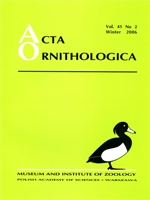Sexual size dimorphism was analysed in the Red- necked Grebe in southeast Poland. A DNA-based procedure was utilised to sex individuals and to assess the accuracy of morphological criteria for the sex identification of adult breeding birds: discriminant analysis on the sample level and within-pair comparisons. Males were significantly larger than females in all body measurements used in the discriminant function selection process. Owing to considerable overlap in measurements, however, the sexes cannot be accurately separated by biometrics at the population scale. Sexual dimorphism was most pronounced in bill length measured from the corner of the gape to the tip, but only 79% of individuals were correctly identified on the basis of this parameter alone. When two variables, bill length and wing length, were combined, the discriminant function was of similar efficiency (80%) in determining the sex. The accuracy level of sexing may be improved by comparing mates within pairs: combined comparisons of bill length and body mass were as accurate as the genetic technique, but sex assignment was restricted to 76% of the measured pairs.
How to translate text using browser tools
1 December 2006
Sexing Red-Necked Grebes Podiceps grisegena by Molecular Techniques and Morphology
Janusz Kloskowski,
Przemysław Grela,
Jarosław Krogulec,
Gaska Michał,
Marek Tchórzewski

Acta Ornithologica
Vol. 41 • No. 2
December 2006
Vol. 41 • No. 2
December 2006
discriminant function analysis
molecular sexing
Podiceps grisegena
Red-necked Grebe
sexual size dimorphism
within-pair comparisons




